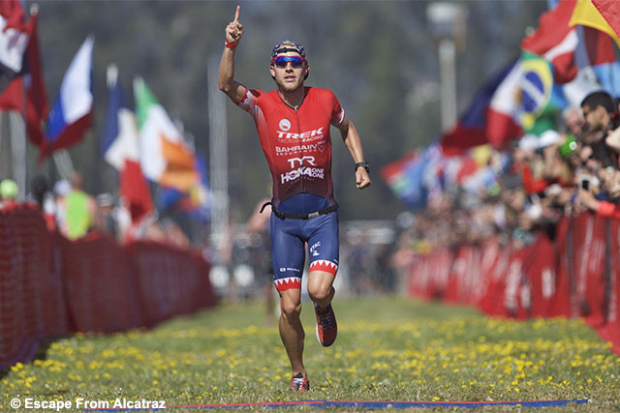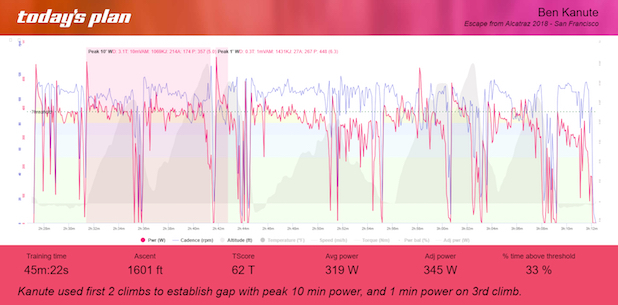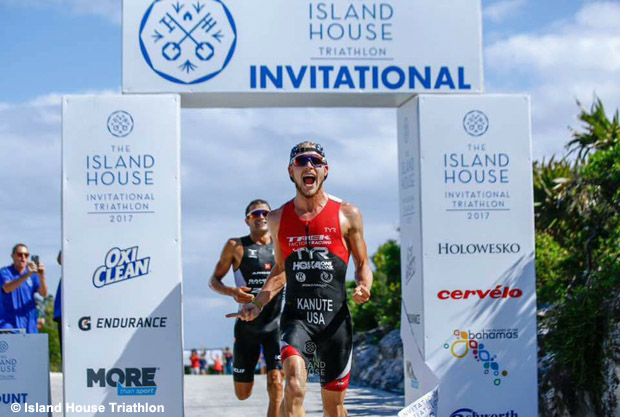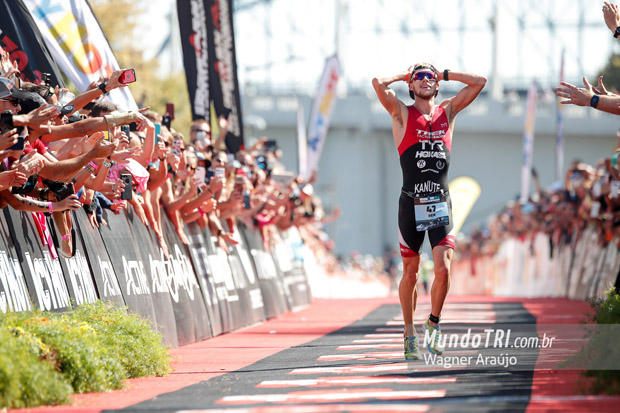Breaking Down Kanute’s Winning Escape
One year after extreme windy conditions cancelled the swim in 2017 at Escape From Alcatraz, it was a picture perfect morning in 2018. Defending men's winner Ben Kanute dove into very flat waters in the San Francisco Bay, against a strong field that included three other Olympians (Andy Potts and Jarrod Shoemaker of the US and Ryan Fisher of Australia), and other top non-drafting stars Cam Dye, Eric Lagerstrom and Jason West.

The Swim
Under sunny skies, warm temps, and only a light breeze, the 57 degree swim was calm and clear with a strong current pushing the top athletes in. Kanute's 1.5 mile swim was a very fast 21:23 and he exited the water first with Fisher, Shoemaker, Dye and Lagerstrom on his heels. Six-time race winner Potts, and West, were a minute further behind but were unable to bridge up to the leaders.

The Bike
Kanute exited T1 with the lead and proceeded to put a 30+ seconds on Dye, and over a minute on past Alcatraz winner Lagerstrom, whose race would unfortunately end at T2 with a foot injury sustained during the run from swim exit to T1. West would be next to enter T2, but 3 minutes down. Let's take a look at where Kanute gained his time advantage on the technical bike course.
Kanute used the first two climbs to produce his peak 10 min power output on the bike and established a gap over those behind, riding 357 watts, which is 5.0 w/kg, a tough effort for many to hold up against. After that 10 min peak, he more aggressively attacked the third climb, where his peak 1 min power output of 448 watts on the bike would come, a 6.3 w/kg output. Both his peak 10 mins and 1 min power outputs came in the first 15 mins of the bike, leaving another 30 mins of hard riding to go. The rest of the way, Kanute was careful to utilize the descents but not do too much that could affect his run. He finished with an average power of only 319 watts, but an adjusted power of 345, which accounts for the surges and time spent descending. You can see these peaks highlighted in his power file and other key stats from the ride. Bike Power file here.
The Standard Deviation of all power samples in the ride was 95 watts, which shows a large discrepancy in the power he produced, due to the climbs, descents and turns. His power file for the bike showed he spent 33% of the race above his threshold watts, estimated at 380 before the race. (Note: Standard Deviation and time spent above threshold provided in his Today’s Plan account).

The Run
Once out of T2, Kanute’s run legs needed to settle in, and he knew with the gaps he had, and 8 miles to run, he needed to pace correctly and work into the run. He ran steady for the first two miles, before the big climbs, including the infamous Sand Ladder at 4.75 miles, where he had the fastest split of the day, at 1:53 up the daunting 400 sandy steps.
When Kanute reached the stairs back down to the bay, his power greatly dropped, allowing gravity to pull him down. His Leg Spring Stiffness, (or LSS), greatly spiked as he absorbed each step jumping down the stairs. At the bottom of the stairs Kanute held 33 seconds on Dye, and 90 secs on West. His early pacing paid off, and he had his fastest 10 mins of pace the final 10 mins of the run, and he was able to soak up the large crowd at the finish. His Run Power/Pace file can be viewed here.
2017 vs 2018
Since Kanute won the 2017 Escape From Alcatraz as well, we can compare his numbers, which are quite surprising.
2017
Bike Split – 43:45
Bike Avg Power – 350w
Run Split (Pace) – 45:38 (5:44/mile)
Sand Ladder (rank) – 1:50 (1st tie)
Run Avg Power – 327w
Avg LSS – 11.01 kN/m
2018
Bike Split – 45:15
Bike Avg Power – 319w
Run Split (Pace) – 49:41 (5:57/mi)
Sand Ladder (rank) – 1:53 (1st)
Run Avg Power – 320w
Avg LSS – 10.10 kN/m
So why such a big drop in all the numbers? Was Kanute not as fit as 2017? As his coach, I can most certainly say that Kanute is fitter than 2017, and in fact, the numbers and data from training show he is significantly fitter than last year.
In 2017, recall that Alcatraz had the swim cancelled, (first time in the 38 year history of the event), and it seems logical to think the bike and run would likely be affected also. With that cancellation, a time trial start where athletes had to push themselves without knowing their general place overall may have affected things as well. The cancelled swim also meant racing at a warmer time of day with a delayed start in 2017, compared to the chilly temps of 2018 race morning.
Another factor of importance is the run course was slightly changed for 2018, with more trails, less road and sidewalk. This would affect run pace, run power and LSS.
Can much be gained from comparing the two? Probably not anything of significance, as Alcatraz is a beast of a race, with different elements and conditions each year.
Lastly, Kanute carried a lot fatigue into this race, coming from a big training camp in San Diego, which may have affected sharpness and output. You can see more on the camp he did in this video by Talbot Cox for Stryd.
Ben is currently hosting an Ask Me Anything thread on the ST Forum.
Next up for Kanute is WTS Leeds, Philadelphia Escape Triathlon, and New York City Triathlon.
Jim Vance is the personal coach of Ben Kanute, and author of Triathlon 2.0, and Run With Power. His website is CoachVance.com




